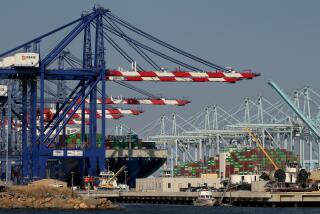Beleaguered Allis-Chalmers Seeks Chapter 11 Protection : Milwaukee-Based Firm Hasnât Posted a Profit Since 1980; UAW Says Filing Imperils Retireesâ Health-Care Benefits
Falling victim to the problems that have been grinding away for years at manufacturers of farm equipment and heavy machinery, a shrunken Allis-Chalmers filed Monday for bankruptcy court protection from its creditors.
In filing for reorganization under Chapter 11 of the U.S. Bankruptcy Code, Allis-Chalmers said that funds generated by its U.S. operations are not adequate to meet its U.S. obligations, primarily debts and health-care benefits programs left over from Allis-Chalmersâ days as a giant machinery manufacturer.
The United Auto Workers, on the other hand, called the filing part of the companyâs historic âmismanagementâ and said the health benefits of 8,000 UAW retirees are in peril.
Under Chapter 11, a company is allowed to continue operating under current management while it works out a plan to pay its debts.
Allis-Chalmers of Milwaukee âmost emphatically will continue to do business,â said Wendell F. Bueche, chairman and chief executive.
Filing Not a Surprise
Only Allis-Chalmersâ domestic operations are included in the Chapter 11 petition, filed in the Southern District of New York. The companyâs U.S. operations accounted for $362 million of its $771 million in sales last year.
The filing did not come as a surprise, because in March, Allis-Chalmers unveiled a proposed restructuring of its debt and capital structure, telling lenders and union representatives that a rapid agreement was essential to avoid a bankruptcy court filing.
âThe service of their debt had come to such a crunch that apparently they thought this was a necessary move,â said William B. Ferguson III, an analyst with Value Line Investment Survey. âThey needed the breathing space.â
For the last few years, Allis-Chalmers has been restructuring and selling businesses after âthe markets fell apart for our equipmentâ because of a slump in agriculture and intense foreign competition, Allis-Chalmers spokeswoman Nancy Deptolla said.
The company sold its agricultural equipment operations in 1985 and its industrial lift trucks and hydro-turbine businesses in 1986. In March, Allis-Chalmers said it intended to sell all its operations, except a division that makes air-conditioning equipment and air pollution control products among other things.
The company now employs about 9,000 people--3,000 in the United States--down from 29,000 in 1979.
Deptolla said she had not seen the companyâs bankruptcy filing and did not know the size of the companyâs assets and debts. Allis-Chalmers said its U.S. cash flow exceeded a negative $24 million in 1986 and was a negative $2 million in the first quarter of 1987. Its last annual profit was in 1980, when it earned $48.2 million.
The United Auto Workers criticized the filing.
âWe are not surprised by the Allis-Chalmers action, coming as it does from a company with a history of mismanagement,â said William Casstevens, UAW vice president and director of the unionâs agricultural implement department. âNevertheless, this comes as another heavy blow inflicted by Allis-Chalmers on our retired members, who were also among the first to suffer from what has now become an epidemic of pension plan terminations.â
Casstevens said the union will talk with Allis-Chalmers about protecting retireesâ health-care benefits. ALLIS-CHALMERS AT A GLANCE Allis-Chalmers manufactures air quality control, fluids handling and solid materials processing equipment. Hard hit by a weak market and continuing losses, the Milwaukee company sold its farm equipment business in 1985 and has been attempting to restructure its finances.
Year ended Dec. 31 1986 1985 1984 Sales (millions) $771 $771 $756 Net losses (millions) (8.6) (168) (261)
Assets $567 million
Employees 9,000
Shares outstanding 14.5 million
52-week price range $2-$4.875
Monday close (NYSE) $2.125, down $0.75
More to Read
Inside the business of entertainment
The Wide Shot brings you news, analysis and insights on everything from streaming wars to production â and what it all means for the future.
You may occasionally receive promotional content from the Los Angeles Times.










